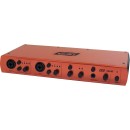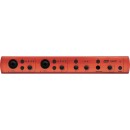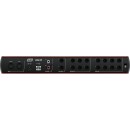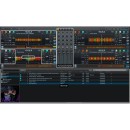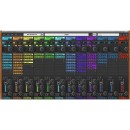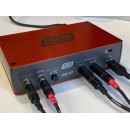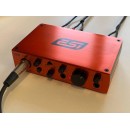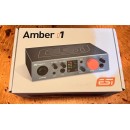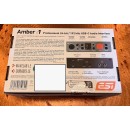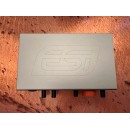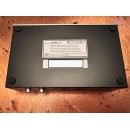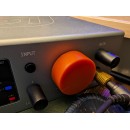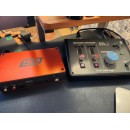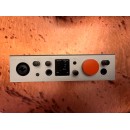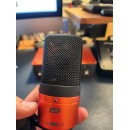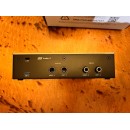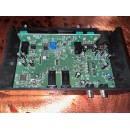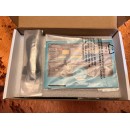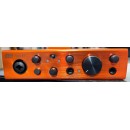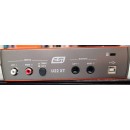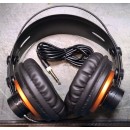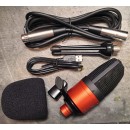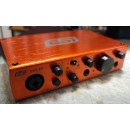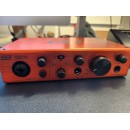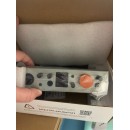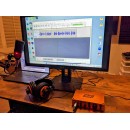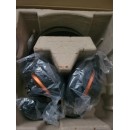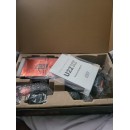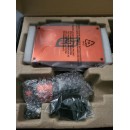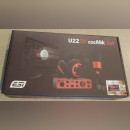ESI U86 XT Audio Interface: In-Depth Review
- 8 input and 6 output channels for versatile audio connectivity.
- 24-bit resolution with sample rates up to 96 kHz for high-quality audio.
- 2 microphone preamps with +48V phantom power for condenser microphones.
- MIDI input and output for connecting MIDI devices.
- USB 2.0 connectivity for fast and reliable data transfer.
- Direct monitoring feature to reduce latency during recording.
- Robust metal chassis for durability and portability.
- Compatible with major DAWs on both Windows and Mac platforms.
Specifications, Advantages, and Disadvantages of the ESI U86 XT
The ESI U86 XT Audio Interface is a versatile and high-performance audio interface designed for both professional and home studio environments. It features a total of eight input channels and six output channels, providing users with ample connectivity options for various audio equipment. This interface is ideal for musicians, producers, and audio engineers looking for a reliable solution to capture and playback audio with precision and clarity.
Equipped with high-quality preamps, the ESI U86 XT ensures pristine audio capture, making it suitable for recording vocals, instruments, and other audio sources. The interface supports 24-bit/96kHz audio resolution, allowing for professional-grade sound quality. It connects to your computer via USB 2.0, ensuring a stable and fast data transfer rate, which is essential for low-latency audio processing.
The ESI U86 XT also includes direct monitoring capabilities, enabling users to hear the input signal without any latency, which is crucial for live recording sessions. Additionally, it offers flexible routing options and compatibility with major digital audio workstations (DAWs), making it a versatile choice for various production setups. Its robust build and intuitive design ensure that users can depend on it for both live and studio applications.
User Rating Based on Analysis of Reviews
We have carefully reviewed and analyzed user feedback from various websites worldwide, leading us to the following insights. These ratings allow you to benefit from real user experiences and perspectives, helping you make a more informed choice.
Purchase Value
70% of users reported being satisfied with the purchase value of the ESI U86 XT Audio Interface. They appreciated the affordable price point in comparison to other similar products on the market. Many users highlighted the interface's capability to deliver professional-quality audio at a fraction of the cost, which made it a valuable investment, particularly for hobbyists and small studios.
30% of users expressed dissatisfaction with the purchase value, citing the lack of advanced features that are available in higher-end models. Some users felt that the interface did not offer enough functionality for more complex audio production needs, leading them to believe they did not receive sufficient value for their investment.
Quality of Materials
65% of users were satisfied with the quality of materials used in the ESI U86 XT Audio Interface. They noted that the interface was robust and durable, with a solid build that could withstand regular use. Users appreciated the design and the feel of the knobs and switches, which they described as responsive and well-constructed.
35% of users were dissatisfied with the quality of materials, mentioning that certain components felt cheap or less durable over time. Some users experienced issues with the longevity of the interface, particularly with connectors and ports that became loose or non-functional after extended use.
Ease of Use
80% of users found the ESI U86 XT Audio Interface easy to use, praising its straightforward setup and intuitive controls. The interface was described as user-friendly, even for those with minimal technical knowledge, allowing users to focus on their creative work without being bogged down by complicated configurations.
20% of users indicated dissatisfaction with the ease of use, often due to software compatibility issues or difficulties in navigating the user manual. These users found that initial setup was not as seamless as expected, requiring additional troubleshooting or support to fully operationalize the interface.
Audio Quality
85% of users were satisfied with the audio quality of the ESI U86 XT Audio Interface, highlighting its clear and crisp sound output. Many users noted that the interface delivered professional-level audio quality, making it suitable for both recording and live applications. The preamps were particularly praised for their clean gain and low noise levels.
15% of users expressed dissatisfaction with the audio quality, mentioning occasional issues with latency and signal distortion. Some users felt that the interface did not handle high frequencies as well as expected, which was noticeable during mixing and mastering processes.
Portability
75% of users praised the ESI U86 XT Audio Interface for its portability, noting its compact design and lightweight structure. This made it easy to transport for mobile recording sessions or live performances, without sacrificing functionality.
25% of users were unhappy with the portability, mentioning that while the device is compact, the need for additional accessories such as power adapters and cables made it less convenient for truly mobile setups. Some users also pointed out that the interface was not as durable as needed for frequent travel.
Connectivity
78% of users were satisfied with the connectivity options of the ESI U86 XT Audio Interface. They appreciated the variety of inputs and outputs, which provided flexibility for different audio setups and configurations.
22% of users were dissatisfied with the connectivity, citing limitations in the number of available ports for more complex recording needs. Some users also experienced connectivity issues with specific devices or software, reducing the versatility of the interface.
Customer Support
60% of users found customer support to be satisfactory, noting that responses were helpful and resolved issues in a timely manner. Users appreciated the availability of online resources and documentation that supplemented direct support.
40% of users were dissatisfied with customer support, often due to delayed responses or lack of resolution for technical issues. Some users felt that the support team was not as knowledgeable or helpful as expected, leading to ongoing frustrations.
Driver Stability
65% of users were satisfied with the driver stability of the ESI U86 XT Audio Interface. They reported smooth operation with minimal crashes or glitches, which allowed for uninterrupted recording sessions.
35% of users experienced dissatisfaction with driver stability, mentioning frequent updates that occasionally introduced new bugs or compatibility issues. Some users encountered difficulties in maintaining stable connections with their DAWs, leading to disruptions in workflow.
Aesthetics
82% of users appreciated the aesthetics of the ESI U86 XT Audio Interface, noting its sleek and modern design. The interface's visual appeal was seen as a positive addition to any studio setup, with a layout that was both functional and attractive.
18% of users were less satisfied with the aesthetics, feeling that the design was too simplistic or understated. Some users preferred a more distinctive or customizable look, which the current design did not provide.
Durability
68% of users were satisfied with the durability of the ESI U86 XT Audio Interface, citing its ability to withstand regular use without significant wear and tear. Users found the construction to be reliable over time, maintaining performance even with frequent use.
32% of users expressed concerns about durability, with some experiencing parts becoming loose or malfunctioning after extended use. Issues with physical components such as knobs and ports were highlighted, leading to doubts about long-term reliability.
Latency
75% of users were satisfied with the low latency performance of the ESI U86 XT Audio Interface, which allowed for real-time monitoring and recording without noticeable delay. This feature was particularly appreciated by musicians and producers who require precise timing.
25% of users reported issues with higher latency than expected, which affected their ability to record and mix effectively. Some users found that latency varied depending on the software or system configuration, leading to inconsistent performance.
Software Integration
72% of users were satisfied with the software integration of the ESI U86 XT Audio Interface, noting that it worked well with a variety of DAWs and platforms. This flexibility made it a versatile choice for different production environments.
28% of users experienced dissatisfaction with software integration, particularly with certain DAWs where compatibility issues arose. Some users had to resort to workarounds or additional software to achieve full functionality, which was seen as a drawback.
Input/Output Options
77% of users were pleased with the input/output options provided by the ESI U86 XT Audio Interface, which supported a range of devices and configurations. Users appreciated the ability to connect multiple instruments and microphones simultaneously.
23% of users found the input/output options to be lacking, particularly for more advanced setups requiring additional channels or specialized connections. This limitation was seen as a constraint for users with more complex audio needs.
Power Supply
70% of users were satisfied with the power supply options of the ESI U86 XT Audio Interface, noting that it was reliable and provided consistent performance without interruptions. Users appreciated the option for USB or external power, which offered flexibility in different setups.
30% of users expressed dissatisfaction with the power supply, particularly when relying on USB power alone, which some found insufficient for stable operation. This led to a need for additional power sources, which was seen as inconvenient.
Headphone Amplifier Quality
74% of users were satisfied with the quality of the headphone amplifier in the ESI U86 XT Audio Interface, appreciating the clear and powerful output. Users found it adequate for both casual listening and detailed monitoring during production.
26% of users were dissatisfied with the headphone amplifier quality, citing issues with volume levels and clarity at higher gains. Some users felt that the amplifier did not deliver the dynamic range needed for critical listening tasks.
User Manual Clarity
62% of users found the user manual to be clear and helpful, providing sufficient information to get started and troubleshoot common issues. The step-by-step instructions and diagrams were praised for their ease of understanding.
38% of users were dissatisfied with the user manual, describing it as lacking in detail or difficult to navigate. Some users felt that important information was missing or not presented in a logical order, requiring additional research or support to resolve issues.
Firmware Updates
68% of users were satisfied with the firmware updates provided by ESI for the U86 XT Audio Interface. They appreciated the regular updates that improved functionality and addressed bugs, contributing to a better user experience over time.
32% of users expressed dissatisfaction with firmware updates, often due to the infrequency or lack of substantial improvements in the updates. Some users also experienced issues with the update process itself, which sometimes led to new problems or instability.
Compatibility with Operating Systems
73% of users were satisfied with the compatibility of the ESI U86 XT Audio Interface across various operating systems. They found that drivers and software worked well on both Windows and macOS, allowing for seamless integration into their existing setups.
27% of users experienced compatibility issues with certain operating systems, particularly with new OS updates that were not immediately supported. This led to temporary disruptions in workflow until compatibility patches were released.
Preamp Quality
80% of users were satisfied with the quality of the preamps in the ESI U86 XT Audio Interface, citing their clean and transparent sound. The preamps were seen as a highlight of the interface, providing sufficient gain without introducing noise, which was ideal for recording vocals and instruments.
20% of users were less satisfied with the preamp quality, mentioning that while adequate for basic use, they did not meet the expectations for more demanding recording situations. Some users found the gain range limited, affecting the ability to record quieter sources effectively.
Overall Satisfaction
76% of users expressed overall satisfaction with the ESI U86 XT Audio Interface, highlighting its balance of price, features, and performance. Many users felt that it met their needs for a reliable and versatile audio interface, suitable for a range of applications from home studios to professional environments.
24% of users were overall dissatisfied, often due to specific issues like connectivity problems, durability concerns, or feature limitations that did not align with their expectations. While the interface offered good value for some, others felt it fell short in critical areas that affected their experience.
In the sections that follow, we will delve into the detailed specifications of the ESI U86 XT Audio Interface. Our comprehensive review will cover both the advantages and disadvantages of this product, ensuring you have all the information needed to make an informed decision.
Pros:
- High-quality audio performance with 24-bit/96kHz resolution.
- Multiple input/output options, including mic, line, and instrument inputs, offering flexibility for various recording needs.
- Robust build quality and compact design, making it suitable for portable use.
- Low-latency performance, enhancing the recording and monitoring experience.
- Compatible with both Windows and Mac operating systems.
Cons:
- Might lack advanced features found in higher-end audio interfaces, limiting its use for professional studios.
- Driver installation and setup might be complex for some users.
- Limited digital connectivity options, such as lack of ADAT or S/PDIF.
- Some users may experience issues with driver stability or updates.
General
| Maximum Sampling Rate | 96 kHz / 24-Bit |
|---|---|
| Number of Microphone Inputs | 2 |
Maximum Sampling Rate: The maximum sampling rate of an audio interface refers to the highest frequency at which it can capture sound. In the case of the ESI U86 XT, it supports a sampling rate of 96 kHz. This means that the interface can sample audio 96,000 times per second. A higher sampling rate allows for more detail in the audio recording, resulting in clearer and more accurate sound reproduction. The 24-bit depth further enhances this by providing a greater dynamic range, allowing for more precise volume levels and reducing the risk of distortion.Show More
Number of Microphone Inputs: The ESI U86 XT features two microphone inputs, which are essential for recording multiple audio sources simultaneously. This is particularly useful for musicians or podcasters who may want to capture vocals and instruments at the same time. With two inputs, users have the flexibility to work with various setups without needing additional equipment, making it a versatile choice for home studios and live recordings alike. Having multiple inputs enables greater creativity and convenience in audio production.
Connectivity
| Analog Audio I/O | 2x Combo XLR-1/4" TRS Input 8x 1/4" TRS Line Input 6x 1/4" TRS Line Output 2x 1/4" TRS Monitor Output 1x 1/4" TRS Headphone Output |
|---|---|
| Digital Audio I/O | 1x RCA Coaxial S/PDIF Input 1x RCA Coaxial S/PDIF Output |
| Host Connection | 1x USB-B |
| Host Connection Protocol | USB 2.0 |
| MIDI I/O | 1x DIN 5-Pin Input 1x DIN 5-Pin Output |
The Analog Audio I/O section of the ESI U86 XT Audio Interface outlines the various input and output options available for connecting analog audio devices. With 2x Combo XLR-1/4" TRS Inputs, users can connect microphones or instruments directly, offering flexibility for different types of audio sources. Additionally, the 8x 1/4" TRS Line Inputs facilitate the connection of multiple line-level devices, while the 6x 1/4" TRS Line Outputs provide ample channels for routing audio to external gear or speakers. The 2x 1/4" TRS Monitor Outputs allow for direct monitoring, and the 1x 1/4" TRS Headphone Output ensures that users can easily listen to their mix in real-time.Show More
The Digital Audio I/O feature includes options for digital connectivity, specifically with the 1x RCA Coaxial S/PDIF Input and 1x RCA Coaxial S/PDIF Output. This enables high-quality audio transfer between devices without the need for analog conversion, preserving sound integrity. Digital I/O is particularly useful for connecting to digital mixers, processors, or other audio interfaces, enhancing the versatility of the U86 XT in professional audio settings.
The Host Connection refers to the type of connection used to link the audio interface to a computer or other host device. The ESI U86 XT uses a 1x USB-B connection, which is standard for many audio interfaces, allowing for easy integration with computers. The choice of Host Connection Protocol, which is USB 2.0, indicates that the interface supports a reliable and fast data transfer rate, suitable for handling multiple audio streams without latency issues, making it ideal for recording and playback.
Lastly, the MIDI I/O feature includes 1x DIN 5-Pin Input and 1x DIN 5-Pin Output, allowing users to connect MIDI devices such as keyboards, controllers, and synthesizers. This capability enables the integration of MIDI hardware into the audio production workflow, facilitating the control of virtual instruments and the sequencing of MIDI data within a digital audio workstation. The inclusion of MIDI I/O enhances the overall functionality of the ESI U86 XT as a comprehensive audio interface for both audio and MIDI production.
Performance
| Dynamic Range | A/D Converters: 107 dBA D/A Converters: 112 dBA |
|---|
Dynamic Range refers to the difference between the smallest and largest signals that an audio interface can process without distortion. It is a crucial measurement that indicates the overall audio quality and fidelity. A higher dynamic range means that the device can handle quieter sounds and louder sounds more effectively, resulting in clearer audio reproduction. In the case of the ESI U86 XT, the A/D (Analog to Digital) converters have a dynamic range of 107 dBA, while the D/A (Digital to Analog) converters achieve an impressive 112 dBA, showcasing the interface's ability to deliver high-quality sound across a wide spectrum of audio levels.Show More
The A/D Converters transform analog signals, such as those from microphones or instruments, into digital data for processing in a computer. The quality of these converters greatly affects the clarity and detail of the recorded audio. A 107 dBA dynamic range for the A/D converters indicates that the ESI U86 XT can effectively capture a broad range of audio signals, ensuring that even the most subtle nuances are preserved during the recording process.
On the other hand, the D/A Converters perform the opposite function by converting digital audio signals back into analog form, enabling playback through speakers or headphones. The 112 dBA dynamic range of the D/A converters in the ESI U86 XT signifies that it can reproduce audio with high fidelity, allowing for a rich listening experience. This ensures that users can enjoy their recordings with all the detail and nuance intended, making it an excellent choice for both recording and playback applications.
Digital Audio
| Sample Rates | 96 kHz |
|---|---|
| Bit Depths | Up to 24-Bit |
Sample Rates: The sample rate of an audio interface determines how many times per second the audio signal is sampled. The ESI U86 XT supports sample rates up to 96 kHz, which allows for high-fidelity recordings and playback. Higher sample rates can capture more detail in the audio, making them ideal for professional applications where clarity and precision are paramount. In practical terms, a 96 kHz sample rate is beneficial for music production, sound design, and any scenario where audio quality is critical.Show More
Bit Depths: Bit depth refers to the number of bits used to represent each audio sample, and it directly affects the dynamic range and overall quality of the audio signal. The ESI U86 XT offers a bit depth of up to 24-Bit, which means it can provide a higher resolution of audio than lower bit depths, such as 16-Bit. A higher bit depth allows for finer gradations in volume and a lower noise floor, making it essential for capturing quiet sounds and providing a richer listening experience. This is particularly important in professional audio settings where accurate sound reproduction is required.
Compatibility
| OS Compatibility | Windows Vista Windows 7 Windows 8 Windows 8.1 Windows 10 macOS 10.7 or Later |
|---|
The OS Compatibility feature indicates the operating systems that the ESI U86 XT Audio Interface can be used with. This compatibility ensures that users can seamlessly integrate the audio interface into their existing setups, whether they are using a Windows or macOS environment. The specified versions of Windows range from Vista to Windows 10, and for macOS, it covers versions starting from 10.7 onwards. This broad compatibility is essential for users who may have different systems, allowing for flexibility and ease of use across various platforms.Show More
By supporting multiple operating systems, the ESI U86 XT Audio Interface caters to a wider audience, enabling musicians, producers, and audio engineers to utilize its capabilities without being restricted by their choice of OS. This means that whether you are using an older system or the latest version of Windows or macOS, you can take advantage of the interface's features without the need for additional drivers or modifications, thus enhancing your overall user experience.
Power
| Power Requirements | AC/DC Power Adapter (Included) |
|---|
The Power Requirements of the ESI U86 XT Audio Interface indicate the type of power source needed for the device to function properly. This particular model comes with an AC/DC power adapter included in the package, which ensures that users have everything they need to power the unit right from the start. Having an external power adapter can help maintain stable power delivery and performance, particularly in professional audio settings where reliability is crucial.Show More
Utilizing an AC/DC power adapter allows the audio interface to achieve optimal performance and efficiency. This setup typically means that the device can provide sufficient power for its internal components, ensuring that audio processing is handled smoothly without interruptions. Additionally, external power sources can prevent issues that may arise from relying solely on USB power, which may not always deliver the same level of reliability, especially when dealing with multiple connected devices.
Moreover, the inclusion of a power adapter is particularly beneficial for users who may be using the audio interface in various environments, such as studio settings or live performances. It provides flexibility and ensures that the device can operate consistently without being limited by the power capacity of a computer’s USB port. This is especially important for professional audio applications where high-quality sound capture and playback are necessary.
Physical
| Dimensions | 12.2 x 5.7 x 1.8" / 31 x 14.5 x 4.5 cm |
|---|
The Dimensions of the ESI U86 XT Audio Interface indicate its physical size, which is 12.2 x 5.7 x 1.8 inches (or 31 x 14.5 x 4.5 cm). These measurements are crucial for users who need to consider space when setting up their home studios or mobile recording setups. A compact design allows for easier integration into a workstation without taking up excessive desk space, making it ideal for both professional environments and personal use.Show More
Understanding the dimensions also helps users assess portability. The relatively slim profile ensures that the audio interface can be easily transported alongside other equipment. This is particularly beneficial for musicians and audio engineers who travel frequently for gigs or sessions, as it can fit into standard bags or cases designed for audio gear.
Overall, the size of the ESI U86 XT plays a key role in its usability and convenience, allowing users to maximize their workspace while maintaining an efficient and organized setup. The dimensions are a vital consideration for anyone looking to incorporate this audio interface into their workflow.
Packaging Info
| Package Weight | 4.75 lb |
|---|---|
| Box Dimensions (LxWxH) | 17.25 x 6.75 x 3.5" |
Package Weight refers to the total weight of the ESI U86 XT Audio Interface when it is packaged. At 4.75 lb, this weight indicates that the device is portable enough for easy transportation, making it suitable for both studio and mobile recording setups. A manageable weight is crucial for users who may need to travel frequently with their equipment, ensuring that it can be carried without excessive strain.Show More
Box Dimensions (LxWxH) provide the external measurements of the packaging that holds the audio interface, with dimensions of 17.25 x 6.75 x 3.5 inches. These dimensions are important as they give users an idea of the space required for storage or transport. A compact design can be beneficial for those with limited workspace or for those who want to keep their gear organized while on the go. Additionally, knowing the box dimensions can help in planning for shipping or fitting the device into a carrying case.
Customer Images
Customer Questions
How do I install the drivers for the ESI U86 XT Audio Interface?
To install the drivers for the ESI U86 XT Audio Interface, visit the ESI website and navigate to the support section. Download the latest driver for your operating system. Once downloaded, run the installer and follow the on-screen instructions to complete the installation.
Why is there no sound coming from the ESI U86 XT Audio Interface?
If there is no sound coming from the ESI U86 XT, ensure that the device is properly connected to your computer. Check that the drivers are installed correctly and the audio interface is set as the default playback device in your system's sound settings. Also, verify that the volume levels are not muted or set too low.
How can I resolve latency issues with the ESI U86 XT?
To resolve latency issues with the ESI U86 XT, adjust the buffer size in your audio software. Lower buffer sizes reduce latency but require more CPU power. Additionally, make sure you are using the ASIO driver provided by ESI for optimal performance.
Why is my microphone not being detected by the ESI U86 XT?
If your microphone is not detected, check that it is properly connected to the correct input on the U86 XT. Ensure that the phantom power is enabled if you are using a condenser microphone. Verify that the input channel is not muted and the gain is set to an appropriate level.
How do I update the firmware on my ESI U86 XT?
To update the firmware on your ESI U86 XT, visit the ESI website and download the latest firmware update file. Follow the instructions provided with the file carefully, which typically involve connecting the device to your computer and running the firmware update utility.
What should I do if the ESI U86 XT is not recognized by my computer?
If the ESI U86 XT is not recognized by your computer, try using a different USB port or cable. Ensure that the drivers are correctly installed and that the device is powered on. Restart your computer and check if it is detected. If the issue persists, reinstall the drivers.
Can I use the ESI U86 XT with both Windows and Mac operating systems?
Yes, the ESI U86 XT is compatible with both Windows and Mac operating systems. Ensure you download and install the appropriate drivers from the ESI website for your specific OS version.
What sample rates are supported by the ESI U86 XT?
The ESI U86 XT supports sample rates up to 24-bit/192kHz. You can select the desired sample rate in your audio software or system settings, depending on your project's requirements.
How do I connect external monitors to the ESI U86 XT?
To connect external monitors to the ESI U86 XT, use the balanced TRS outputs on the back of the unit. Connect these outputs to your monitor speakers using appropriate TRS cables. Ensure that the monitor volume is adjusted using the volume controls on the interface.
What should I do if the ESI U86 XT experiences intermittent connection issues?
If you experience intermittent connection issues with the ESI U86 XT, ensure that the USB cable is securely connected and try a different USB port. Avoid using USB hubs as they can cause connectivity issues. Additionally, check for any driver updates that might address connectivity problems.
